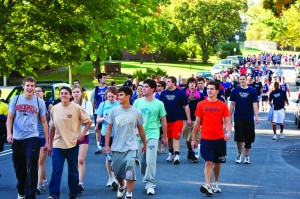By Jessica Domsky
Contributing Writer
To use the Susquehanna River’s natural beauty, as well as create both outdoor academic and recreational opportunities for the campus community, the University has created a new dock behind the facilities shop at the end of River Road.
The dock opens direct access to the river from campus and is open from dawn to dusk, giving students, faculty and staff three-season access to canoeing, kayaking and fishing opportunities. Students and faculty also have access to the river for research and teaching.
“The dock is a wonderful place to land or launch a personal float trip as well as recreational trips for the Outing Club or other outdoor education and leadership supported trips,” said Poppy Goforth, director of outdoor education and leadership. “I can’t wait to see students, faculty and staff down there enjoying the river and all it has to offer.”
The Susquehanna River, host to numerous wildlife and water activities, has been an important aspect of the University since the early 1900s.
“I like the fact that the river is just a few yards from my office,” said Jim Hostetler, director of construction and design. “I can get a sense of remoteness and the tranquility that comes along with it.”
As a part of the master plan for the University, former President Brian C. Mitchell began pursuing the idea of a possible connection point between campus and the river at a 4.3 acre tract acquired from the Lewisburg Area Joint Sewer Authority. Soon after, Mitchell authorized money for the design.
The project itself became possible from donor contributions, particularly from long-time University supporter Ben Sampson ’69, and the Degenstein Foundation. Donor contributions made it possible to build the present phase during the summer.
Bucknell Landing is a way for the campus community to reconnect with the river, and students, faculty and staff eagerly anticipate its opening.
“The dock seems like it will be a great addition to Bucknell,” said Rebecca Coldwell ’11, environmental studies major and current Bucknell on the Susquehanna participant. “I hope to get a chance to use it for some of my classes!”
The grand opening of the new dock, originally scheduled for Thursday, was postponed due to poor weather. The grand opening will now be held next spring. Experienced students will give basic kayak instruction.
The modular dock will come out of the water prior to the start of winter and will be launched again each spring.
“We are hoping to start a new ongoing tradition in which students celebrate the oncoming of spring by putting the floatable dock into the river,” Hostetler said.
There has been discussion and debate over whether or not the Landing will be developed further and if so, what it will look like.
“It would be great if faculty and students took ownership of the parcel. Ideally, faculty and students might appoint an advisory committee to plan how it’s used, monitor the site and consider any further development. It could present numerous learning opportunities,” Hostetler said.
“I encourage feedback from members of the Bucknell Community,” Goforth said, “and I hope that whatever happens next at the Landing, if anything at all, is done with support and consensus from the University as a whole.”


